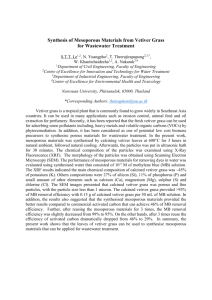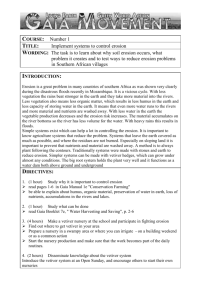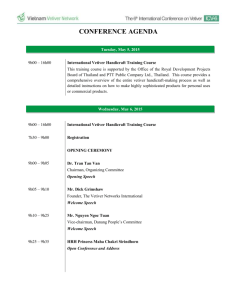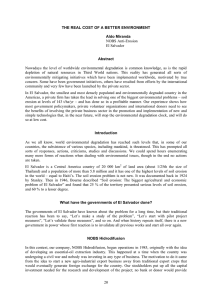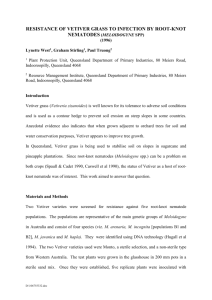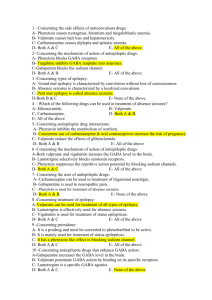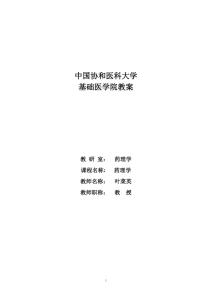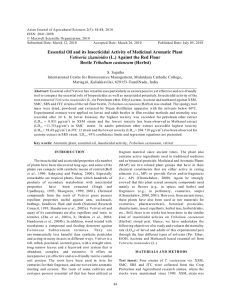Document 13309699
advertisement
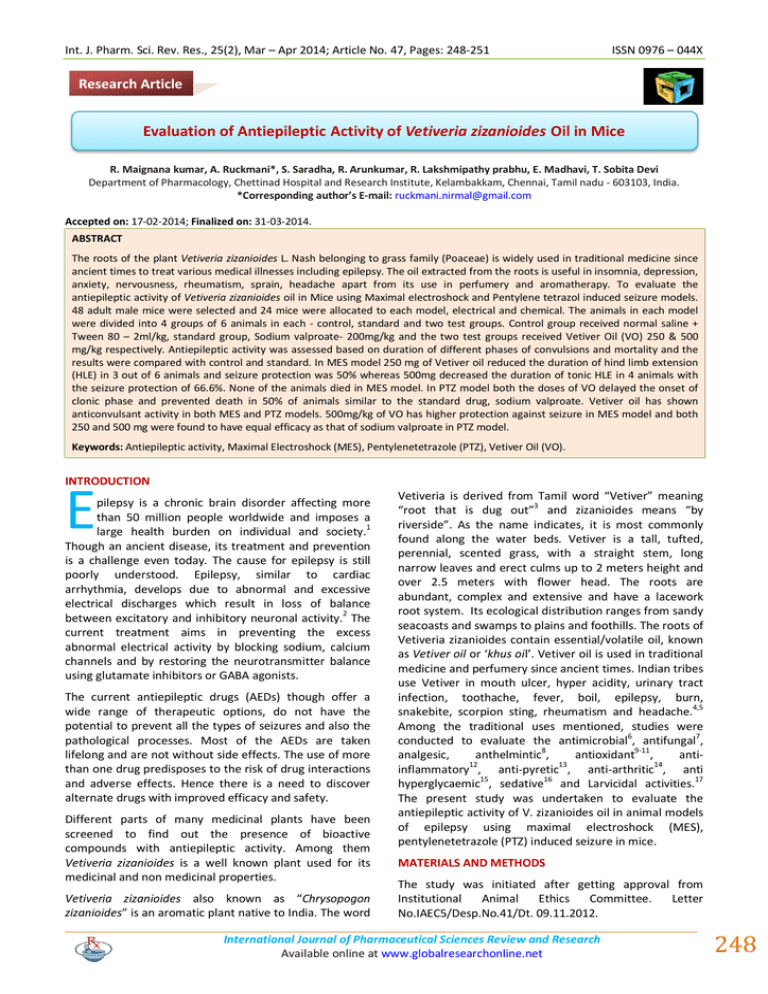
Int. J. Pharm. Sci. Rev. Res., 25(2), Mar – Apr 2014; Article No. 47, Pages: 248-251 ISSN 0976 – 044X Research Article Evaluation of Antiepileptic Activity of Vetiveria zizanioides Oil in Mice R. Maignana kumar, A. Ruckmani*, S. Saradha, R. Arunkumar, R. Lakshmipathy prabhu, E. Madhavi, T. Sobita Devi Department of Pharmacology, Chettinad Hospital and Research Institute, Kelambakkam, Chennai, Tamil nadu - 603103, India. *Corresponding author’s E-mail: ruckmani.nirmal@gmail.com Accepted on: 17-02-2014; Finalized on: 31-03-2014. ABSTRACT The roots of the plant Vetiveria zizanioides L. Nash belonging to grass family (Poaceae) is widely used in traditional medicine since ancient times to treat various medical illnesses including epilepsy. The oil extracted from the roots is useful in insomnia, depression, anxiety, nervousness, rheumatism, sprain, headache apart from its use in perfumery and aromatherapy. To evaluate the antiepileptic activity of Vetiveria zizanioides oil in Mice using Maximal electroshock and Pentylene tetrazol induced seizure models. 48 adult male mice were selected and 24 mice were allocated to each model, electrical and chemical. The animals in each model were divided into 4 groups of 6 animals in each - control, standard and two test groups. Control group received normal saline + Tween 80 – 2ml/kg, standard group, Sodium valproate- 200mg/kg and the two test groups received Vetiver Oil (VO) 250 & 500 mg/kg respectively. Antiepileptic activity was assessed based on duration of different phases of convulsions and mortality and the results were compared with control and standard. In MES model 250 mg of Vetiver oil reduced the duration of hind limb extension (HLE) in 3 out of 6 animals and seizure protection was 50% whereas 500mg decreased the duration of tonic HLE in 4 animals with the seizure protection of 66.6%. None of the animals died in MES model. In PTZ model both the doses of VO delayed the onset of clonic phase and prevented death in 50% of animals similar to the standard drug, sodium valproate. Vetiver oil has shown anticonvulsant activity in both MES and PTZ models. 500mg/kg of VO has higher protection against seizure in MES model and both 250 and 500 mg were found to have equal efficacy as that of sodium valproate in PTZ model. Keywords: Antiepileptic activity, Maximal Electroshock (MES), Pentylenetetrazole (PTZ), Vetiver Oil (VO). INTRODUCTION E pilepsy is a chronic brain disorder affecting more than 50 million people worldwide and imposes a large health burden on individual and society.1 Though an ancient disease, its treatment and prevention is a challenge even today. The cause for epilepsy is still poorly understood. Epilepsy, similar to cardiac arrhythmia, develops due to abnormal and excessive electrical discharges which result in loss of balance between excitatory and inhibitory neuronal activity.2 The current treatment aims in preventing the excess abnormal electrical activity by blocking sodium, calcium channels and by restoring the neurotransmitter balance using glutamate inhibitors or GABA agonists. The current antiepileptic drugs (AEDs) though offer a wide range of therapeutic options, do not have the potential to prevent all the types of seizures and also the pathological processes. Most of the AEDs are taken lifelong and are not without side effects. The use of more than one drug predisposes to the risk of drug interactions and adverse effects. Hence there is a need to discover alternate drugs with improved efficacy and safety. Different parts of many medicinal plants have been screened to find out the presence of bioactive compounds with antiepileptic activity. Among them Vetiveria zizanioides is a well known plant used for its medicinal and non medicinal properties. Vetiveria zizanioides also known as “Chrysopogon zizanioides” is an aromatic plant native to India. The word Vetiveria is derived from Tamil word “Vetiver” meaning “root that is dug out”3 and zizanioides means “by riverside”. As the name indicates, it is most commonly found along the water beds. Vetiver is a tall, tufted, perennial, scented grass, with a straight stem, long narrow leaves and erect culms up to 2 meters height and over 2.5 meters with flower head. The roots are abundant, complex and extensive and have a lacework root system. Its ecological distribution ranges from sandy seacoasts and swamps to plains and foothills. The roots of Vetiveria zizanioides contain essential/volatile oil, known as Vetiver oil or ‘khus oil’. Vetiver oil is used in traditional medicine and perfumery since ancient times. Indian tribes use Vetiver in mouth ulcer, hyper acidity, urinary tract infection, toothache, fever, boil, epilepsy, burn, snakebite, scorpion sting, rheumatism and headache.4,5 Among the traditional uses mentioned, studies were conducted to evaluate the antimicrobial6, antifungal7, analgesic, anthelmintic8, antioxidant9-11, anti12 13 inflammatory , anti-pyretic , anti-arthritic14, anti hyperglycaemic15, sedative16 and Larvicidal activities.17 The present study was undertaken to evaluate the antiepileptic activity of V. zizanioides oil in animal models of epilepsy using maximal electroshock (MES), pentylenetetrazole (PTZ) induced seizure in mice. MATERIALS AND METHODS The study was initiated after getting approval from Institutional Animal Ethics Committee. Letter No.IAEC5/Desp.No.41/Dt. 09.11.2012. International Journal of Pharmaceutical Sciences Review and Research Available online at www.globalresearchonline.net 248 Int. J. Pharm. Sci. Rev. Res., 25(2), Mar – Apr 2014; Article No. 47, Pages: 248-251 Drugs PTZ was purchased from Sigma Chemicals, Vetiver oil from Falcon Chemicals, Tween 80 from Merck Chemicals and Injection Sodium valproate of Sanofi Synthelabo (India) was purchased from the pharmacy of Chettinad Hospital and Research Institute. The test drug was prepared by mixing Vetiver oil with Tween 80 (emulsifying agent) & distilled water in the standard ratio of 4:2:1 (oil/emulsifying agent/water) to obtain the o/w emulsion of the Vetiver oil. The milky white emulsion obtained was further diluted with distilled water so that the concentration of VO obtained was 1gm/ml of emulsion. Animals 48 healthy adult male Swiss albino mice weighing between 25-30 grams were obtained from the Central Animal House of Chettinad Academy of Research Education. 24 mice were allocated to MES model and 24 to PTZ model. Animals in each model were divided in to 4 groups of 6 mice in each. Each group was housed in clean polypropylene cage in a well controlled environment with a 12 hour light and dark cycle along with free access to food and water. The animals were acclimatized for one week in the laboratory before the experiment. ISSN 0976 – 044X indicated anticonvulsant activity. The results were tabulated and analyzed. Statistical Analysis Statistical analysis was done using one way ANOVA. P valve of < 0.05 was considered significant. RESULTS A. MES model All the animals developed convulsions in control group but none of them died. 5 out of 6 animals did not develop convulsion in Standard group treated with Sodium valproate. The percentage of protection against convulsion was 83.3%. In the test group I, which was given 250mg/kg of VO, 3 out of 6 animals did not develop convulsion and the percentage of protection was 50%. In test group II (VO-500mg/kg) 4 animals did not develop seizure and percentage of protection was 66.6%. Statistical analysis of antiepileptic activity in MES model has shown that VO significantly decreased the duration of hind limb extension in both 250mg/kg (P<0.01) and 500mg/kg (P<0.001) VO. The maximum seizure protection (66.6%) seen with 500mg/kg of VO was but lower than that of sodium valproate which offered 83.3% protection. (Table 1) Dosage B. PTZ model From the acute and sub acute toxicity studies conducted earlier LD50 was found to be 2985mg/kg 18. One-fifth of LD50 was taken as the maximum dose (500mg/kg) and one-tenth of LD50 as minimum dose (250mg/kg). All the animals died in the control group. The delay in the onset of clonic phase and the number of animals died were found to be similar in the standard and the test groups. 50% protection was seen in all the three groups. 3 Out of 6 animals died in standard as well as the two test groups. Both 250 and 500mg VO produced same result as that of standard. MES model All the drugs were given intra peritoneal 30 minutes before inducing convulsions. The control animals were given normal saline + Tween 80 – 2ml/kg, the standard group received sodium valproate 200mg/kg and the two test groups were administered with 250(Test I) and 500mg/kg (Test II) of Vetiver oil. Generalized seizure was induced with convulsiometer through a pair of ear electrodes using alternating current of constant frequency (60Hz) and 50mA for 0.2sec. An animal was considered protected if the characteristic electroshock convulsion is absent or there is reduction in the duration of hind limb extension. The duration of hind limb extension and percentage of animals protected in each group were recorded. PTZ model The mice were divided into four groups of 6 animals each. The control, standard and test drugs were administered in the same dosage as in MES model by intra peritoneal route 30 minutes before administration of 80 mg/kg of PTZ subcutaneously. Typical convulsions began in control group with jerking movements of the body followed by clonic convulsions within 2-3 minutes. The test groups were compared to that of control and standard for delay/prolong in the latency of onset convulsions which Statistical analysis of antiepileptic activity in PTZ model has shown that the percentage of animals protected was found to be the same in both sodium valproate and VO treated groups (P<0.05). (Table 2) No significant statistical difference was found between the standard and the test in both the models. DISCUSSION From the results it was seen that VO had antiepileptic action. The extent of antiepileptic action was observed to be different between MES and PTZ model. The antiepileptic activity was found to be lower than sodium valproate in MES model whereas it was found to be equal in PTZ model. Between the doses of VO 500mg/kg offered higher protection in MES model whereas both the doses exhibited the same effect in PTZ model. Statistical analysis had shown that there was no difference between the test and the standard. This indicates that VO preparations will have therapeutic benefit equal to that of sodium valproate in petit mal epilepsy and in grandmal epilepsy it will have an additive effect when given along with other antiepileptic drugs. International Journal of Pharmaceutical Sciences Review and Research Available online at www.globalresearchonline.net 249 Int. J. Pharm. Sci. Rev. Res., 25(2), Mar – Apr 2014; Article No. 47, Pages: 248-251 ISSN 0976 – 044X Table 1: Duration of hind limb tonic extension and Percentage of seizure inhibition in MES model Group (n=6) Mean ± SEM (seconds) Control Hind Limb Tonic Extension (HLTE) Protection against seizure (%) Present (+) Absent (-) 15.833±0.5426 6 0 0 Standard 1.167±1.167** 1 5 83.3 Test I 5.500±2.473* 3 3 50 Test II 2.833±1.797** 2 4 66.6 Values are expressed as MEAN±S.E.M. *P<0.01 ** P<0.001when compared to Control. Table 2: Onset of clonic convulsion and Percentage of animals protected from death in PTZ model No of animals Dead Alive Protection against seizure (%) 2.000±0.001 6 0 0 Standard 3.667±0.4944* 3 3 50 Test I 2.833±0.3073 3 3 50 Test II 3.500±0.4282* 3 3 50 Group (n=6) Mean ± SEM (minutes) Control Values are expressed as MEAN±S.E.M. * P<0.05 compared to Control. The Vetiver oil has more than 120 active chemical constituents. Most of the compounds can be grouped into aliphatic compounds (acyclic organic compounds), terpenes and terpene derivatives, benzene derivatives and miscellaneous compounds. Among them sesquiterpene which belongs to the class of terpenes, are known to have antiepileptic activity.19,20 Hence sesquiterpene in Vetiver oil may be responsible for anticonvulsant activity. It has been reported that Vetiver oil has protective activity against carbon tetra chloride induced hepato toxicity in animals and this action is mediated through the regulation of mitochondrial voltage-dependent anion channels present in the mitochondrial outer membrane.21 The most common anion present in the brain is chloride ions. Increased activity of chloride ions causes neuronal inhibition. Vetiver oil is also known to have sedative effect and terpinen-4-ol (alcoholic group of sesquiterpene) present in Vetiver oil, is a CNS depressant which can facilitate GABA activity.22 The facilitatory effect of Vetiver oil on voltage dependent chloride ion channel and the delay in the occurrence of convulsions in PTZ model might be due to the facilitation of GABA activity. GABA facilitation similar to benzodiazepines & barbiturates can result in antiepileptic activity. In MES model decreased duration of hind limb extension is reported to be due to inhibition of calcium ion conductance. Hence the mechanism of protection in grandmal epilepsy could be due to the inhibition of calcium ion channels. The mechanism of action of sodium valproate is inhibition of sodium and calcium ions as well as facilitation of GABA, chloride channels. VO appears to have similar mechanism of action of inhibiting calcium and facilitating chloride ions. The available evidences also show that Vetiver oil has facilitatory action on chloride channel and inhibitory action on calcium channel and both the actions could contribute to the anticonvulsant effect. Thus it is reported that Vetiver oil has antiepileptic activity in both MES and PTZ induced epilepsy. The efficacy of Vetiver oil when compared to control was found to be significantly greater. In MES model its effect was found to be lesser than sodium valproate but in PTZ model it was found to be equal to sodium valproate. Hence it can be used as an adjuvant drug along with other drugs in grandmal epilepsy. Whereas it can be used as an equivalent drug to other conventional drugs in generalized myoclonic and absence seizures. VO will facilitate the action of other antiepileptic drugs and the synergism that could occur will contribute to reducing the dose and adverse effects of the co-administered drugs. CONCLUSION The present study has shown that VO has anticonvulsant activity in both MES and PTZ mice models. VO exhibited equal efficacy as that of sodium valproate in PTZ model and comparatively lesser effect in MES model and thus it has a potential to be used as a sole antiepileptic /adjuvant drug in epilepsy. The antiepileptic activity of VO could be due to its rich content of sesquiterpenes which are known to have anticonvulsant action. The mechanism of action can be attributed to facilitation of chloride ion channel as well as inhibition of calcium channel. Further studies are needed to evaluate its mechanism of action, translate these findings into clinical trials and develop Vetiver oil as a new antiepileptic drug. International Journal of Pharmaceutical Sciences Review and Research Available online at www.globalresearchonline.net 250 Int. J. Pharm. Sci. Rev. Res., 25(2), Mar – Apr 2014; Article No. 47, Pages: 248-251 REFERENCES ISSN 0976 – 044X 13. Narkhede MB, Ajmire PV, Wagh AE, Bhise MR, Mehetre GD, Patil HJ, An evaluation of anti-pyretic potential of Vetiveria zizanioides (Linn.) root, RJPP, 04(1), 2012. 1. WHO, Epilepsy World Health Organization. www.who.int/mental_health/neurology/epilepsy/en/ 2. Porth CM, Pathophysiology - Concepts of altered health th states, 6 ed, Lippincott Williams & Wilkins, Philadelphia, 2002. 3. Mohammed Nazrul Islam Bhuiyan, Jasim Uddin Chowdhurya, Jaripa Begum, Essential Oil in Roots of Vetiveria zizanioides (L.) Nash Ex Small from Bangladesh Bangladesh J. Bot, 37(2), 2008, 213-215. 4. Rao RR, Suseela MR, Vetiveria zizanioides (Linn.) Nash – A multipurpose Eco-friendly grass of India, In: Preceedings of ICV-2, 444-448. 5. Lavania UC, Other Uses and Utilization of Vetiver: Vetiver Oil, Central Institute of Medicinal and Aromatic Plants, Lucknow, 2006. 6. Suaib Luqman, Detection of antibacterial activity in spent roots of two Genotypes of aromatic grass Vetiveria zizanioides, Pharmaceutical Biology, 43(8), 2005, 732–736. 17. Krishnamoorthy Yogalakshmi, Marimuthu Govindarajan, Rajamohan Sivakumar, Kaliyan Veerakumar, Larvicidal property of vetiver essential oil (Vetiveria zizanoides. L) against culex tritaeniorhynchus (diptera: culicidae), International Journal of Current Science and Technology, 2(1), 2013, 1-3. 7. Devprakash, Prashant Singh, Srinivasan KK, Subburaju T, Sachin K Singh, Antifungal activity of alcoholic and aqueous extracts of Vetiveria zizanioides, Journal of Pharmaceutical Research And Opinion, 1(3), 2011, 85-88. 18. Darpan Kaushik, Rashmi Tripathi, Asish Tripathi, Vijayakumar Rasal P, Suroor Ahmed Khan, Acute and Subacute Toxicity Studies on Vetiver Oil in Rats, FABAD J. Pharm. Sci, 31, 2006, 71-77. 8. Sanjay Kumar Karan, Dilipkumar Pal, Dhirendra Kumar Tarai, Sagar Kumar Mishra, Analgesic and anthelmintic activity of Vetiveria Zizanioides root, Journal of Pharmacy Research, 3(4), 2010, 893-894. 19. Suresh Kumar, Reecha Madaan, Gundeep Bansal, Anupam Jamwal, Anupam Sharma, Plants and Plant Products with Potential Anticonvulsant Activity–A Review, Pharmacognosy Communications, 2(1), 2012. 9. Subhadra devi V, Asok kumar K, Uma maheswari M, In vitro antioxidant activity of Vetiveria zizanioides root extract, Tanzania Journal of Health Research, 12(2), 2010, 1-8. 20. Nagaraja TS, Mohamood R, Krishna V, Thippeswamy BS, Veerapur VP, Anticonvulsant activity of Erythrina mysorensis bark extract in an animal model of epilepsy. J Pharmacol Pharmacother, 3(1), 2012, 62-4. 10. Dhirendra Kumar Tarai, SuryakantaNayak, In vitro free radical scavenging activity of Vetiveria zizanioides, Journal of Pharmacy Research, 3(4), 2010, 681-683. 11. Feng Chen, Xi Wang and Hyun-jin Kim, Antioxidant, anticarcinogenic and termiticidal activities of Vetiver Oil, Proceeding of third international Vetiver, China 2003. 12. Mahesh Narkhede B, Atul Wagh E, Ashish Rathi M, Antiinflammatory activity of Vetiveria zizanioides (linn.) Root, Journal of Pharmacy Research, 5(4), 2012, 2016-2017. 14. Tara Shankar Basuri, Modi Vishal, Anti-arthritic activity of root extracts of Vetiveria zizanioides, Journal of Pharmacy Research, 4(4), 2011, 1240-1241. 15. Sanjay kumar karan, Antihyperglycaemic Effect of Vetiveria zizanioides (L.) Nash Root Extract in Alloxan Induced Diabetic Rats, Asian Journal of Chemistry, 25(3), 2013, 1555-1557. 16. Sirinan Thubthimthed, Krittiya Thisayakorn, UbonRerk-am, Sinn Tangstirapakdee, Taweesak Suntorntanasat, Vetiver Oil and Its Sedative Effect, Thailand Institute of Scientific and Technological Research, Thailand. 21. Parmar MY, Shah PA, Gao J, Gandhi TR, Mitochondrial modulation as a potential mechanism of Vetiveria zizanioides root extract against liver damage in mice, The Egyptian Journal of Biochemistry and Molecular Biology, 29(1), 2011, 1687-1502. 22. Damião de Sousaa P, Franklin Nóbregab Liana FF, de Moraisb CSL, Reinaldo de Almeidab N, Evaluation of the Anticonvulsant Activity of Terpinen-4-ol, Z. Naturforsch, 64, 2009, 1-5. Source of Support: Nil, Conflict of Interest: None. International Journal of Pharmaceutical Sciences Review and Research Available online at www.globalresearchonline.net 251
